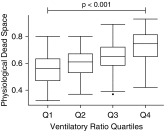Physiologic Analysis and Clinical Performance of the Ventilatory Ratio in Acute Respiratory Distress Syndrome
- PMID: 30211618
- PMCID: PMC6363976
- DOI: 10.1164/rccm.201804-0692OC
Physiologic Analysis and Clinical Performance of the Ventilatory Ratio in Acute Respiratory Distress Syndrome
Abstract
Rationale: Pulmonary dead space fraction (Vd/Vt) is an independent predictor of mortality in acute respiratory distress syndrome (ARDS). Yet, it is seldom used in practice. The ventilatory ratio is a simple bedside index that can be calculated using routinely measured respiratory variables and is a measure of impaired ventilation. Ventilatory ratio is defined as [minute ventilation (ml/min) × PaCO2 (mm Hg)]/(predicted body weight × 100 × 37.5).
Objectives: To determine the relation of ventilatory ratio with Vd/Vt in ARDS.
Methods: First, in a single-center, prospective observational study of ARDS, we tested the association of Vd/Vt with ventilatory ratio. With in-hospital mortality as the primary outcome and ventilator-free days as the secondary outcome, we tested the role of ventilatory ratio as an outcome predictor. The findings from this study were further verified in secondary analyses of two NHLBI ARDS Network randomized controlled trials.
Measurements and main results: Ventilatory ratio positively correlated with Vd/Vt. Ordinal groups of ventilatory ratio had significantly higher Vd/Vt. Ventilatory ratio was independently associated with increased risk of mortality after adjusting for PaO2/FiO2, and positive end-expiratory pressure (odds ratio, 1.51; P = 0.024) and after adjusting for Acute Physiologic Assessment and Chronic Health Evaluation II score (odds ratio, 1.59; P = 0.04). These findings were further replicated in secondary analyses of two separate NHLBI randomized controlled trials.
Conclusions: Ventilatory ratio correlates well with Vd/Vt in ARDS, and higher values at baseline are associated with increased risk of adverse outcomes. These results are promising for the use of ventilatory ratio as a simple bedside index of impaired ventilation in ARDS.
Keywords: ARDS; dead space; ventilatory ratio.
Figures




Comment in
-
Physiological Markers for Acute Respiratory Distress Syndrome: Let's Get More Efficient!Am J Respir Crit Care Med. 2019 Feb 1;199(3):260-261. doi: 10.1164/rccm.201809-1653ED. Am J Respir Crit Care Med. 2019. PMID: 30240279 No abstract available.
References
-
- Nuckton TJ, Alonso JA, Kallet RH, Daniel BM, Pittet JF, Eisner MD, et al. Pulmonary dead-space fraction as a risk factor for death in the acute respiratory distress syndrome. N Engl J Med. 2002;346:1281–1286. - PubMed
-
- Lucangelo U, Bernabè F, Vatua S, Degrassi G, Villagrà A, Fernandez R, et al. Prognostic value of different dead space indices in mechanically ventilated patients with acute lung injury and ARDS. Chest. 2008;133:62–71. - PubMed
-
- Sinha P, Flower O, Soni N. Deadspace ventilation: a waste of breath! Intensive Care Med. 2011;37:735–746. - PubMed
-
- Sinha P, Fauvel NJ, Singh S, Soni N. Ventilatory ratio: a simple bedside measure of ventilation. Br J Anaesth. 2009;102:692–697. - PubMed
-
- Radford EP., Jr Ventilation standards for use in artificial respiration. J Appl Physiol. 1955;7:451–460. - PubMed
Publication types
MeSH terms
Grants and funding
LinkOut - more resources
Full Text Sources
Other Literature Sources
Medical

